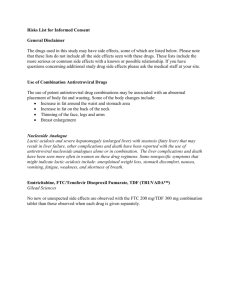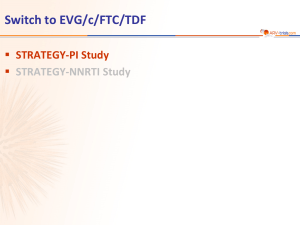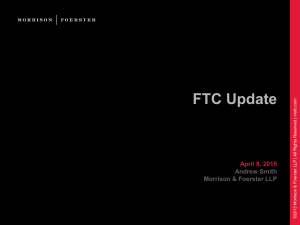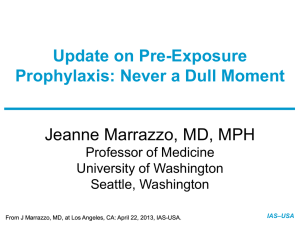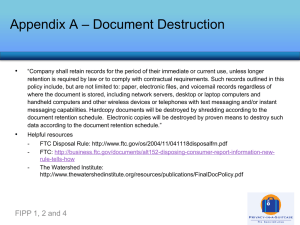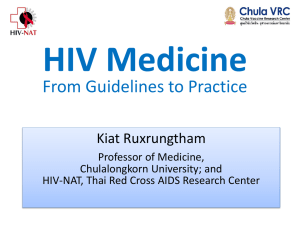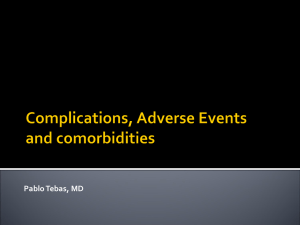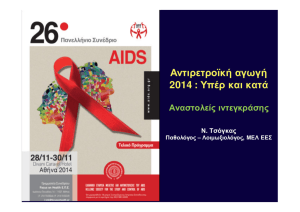Reviewed by:
advertisement
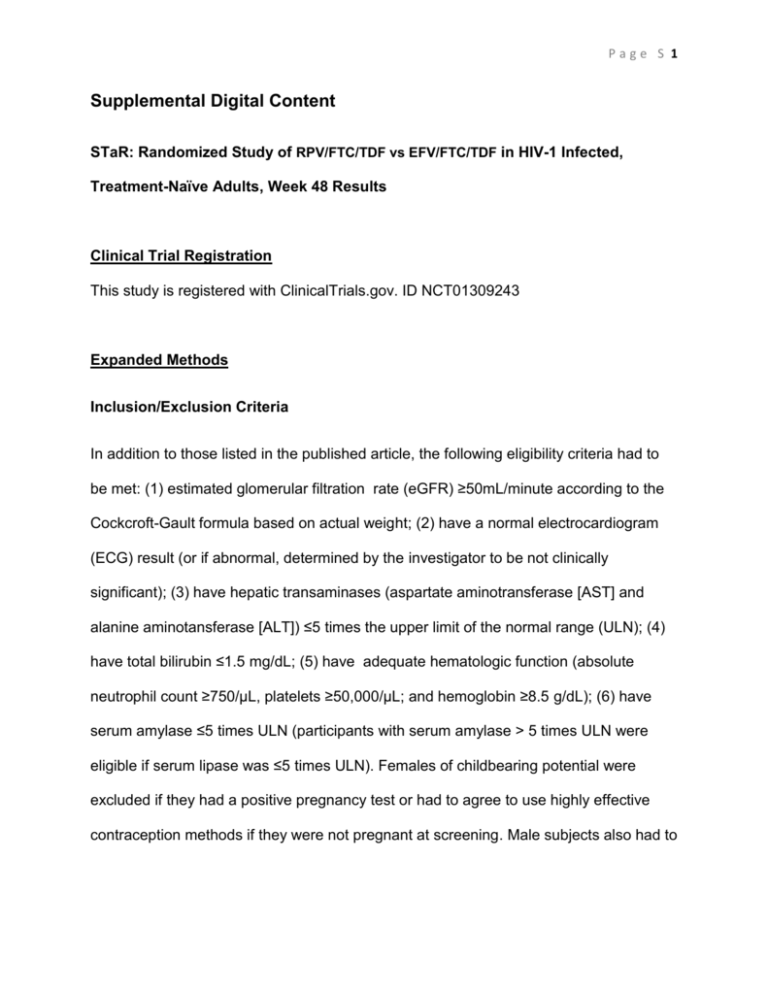
Page S 1 Supplemental Digital Content STaR: Randomized Study of RPV/FTC/TDF vs EFV/FTC/TDF in HIV-1 Infected, Treatment-Naïve Adults, Week 48 Results Clinical Trial Registration This study is registered with ClinicalTrials.gov. ID NCT01309243 Expanded Methods Inclusion/Exclusion Criteria In addition to those listed in the published article, the following eligibility criteria had to be met: (1) estimated glomerular filtration rate (eGFR) ≥50mL/minute according to the Cockcroft-Gault formula based on actual weight; (2) have a normal electrocardiogram (ECG) result (or if abnormal, determined by the investigator to be not clinically significant); (3) have hepatic transaminases (aspartate aminotransferase [AST] and alanine aminotansferase [ALT]) ≤5 times the upper limit of the normal range (ULN); (4) have total bilirubin ≤1.5 mg/dL; (5) have adequate hematologic function (absolute neutrophil count ≥750/µL, platelets ≥50,000/µL; and hemoglobin ≥8.5 g/dL); (6) have serum amylase ≤5 times ULN (participants with serum amylase > 5 times ULN were eligible if serum lipase was ≤5 times ULN). Females of childbearing potential were excluded if they had a positive pregnancy test or had to agree to use highly effective contraception methods if they were not pregnant at screening. Male subjects also had to Page S 2 agree to use protocol-recommended methods of birth control during heterosexual intercourse. Concomitant Medications Use of all medications listed as having a potent CYP3A4 inhibition and herbal/natural supplements were discouraged due to potential pharmacokinetic interactions that could result in increased exposure to study medication. It was also recommended that consuming large quantities of grapefruit juice be avoided, given its CYP3A4 inhibitory effect. Additionally, medications shown in the list that follows were disallowed. Page S 3 Drug Class Agents Disallowed* Analeptics Modafinil Antiarrythmics Bepridil Anticonvulsants Phenobarbital, carbamazepine, oxarbazepine, and phenytoin Antibiotics Rifabutin, rifampin, rifapentine, telithromycin, troleandomycin Antibacterials Telithromycin Antidiabetics Pioglitazone, troglitazone Antifungals Voriconazole Antihistamines Astemizole, terfenadine Antimycobacterials Rifampin, rifapentine, rifabutin Calcium Channel Blockers Bepridil GI Motility Agents Cisapride Glucocorticoids (systemic) Dexamethasone and other glucocorticoids Ergot Derivatives Ergotamine, ergnovine, dihydroergotamine, methylergonovine Herbal/Natural Supplements St. John’s wort, Echinacea Progestogens Megestrol acetate Proton Pump Inhibitors Omeprazole, lansoprazole, rabeprazole, pantoprazole, esomeprazole Neuroleptics Pimozide Sedatives/Hypnotics Midazolam, triazolam *Administration of any of the above medications must be discontinued at least 21 days prior to the Baseline/Day 1 visit and for the duration of the study Page S 4 Outcomes Analysis Efficacy was also evaluated by missing equals excluded analysis of the intent-to-treat (ITT) population Expanded Results Subject Disposition The planned sample size was 700 subjects (350 in each treatment group). A total of 799 subjects were actually enrolled. Over-enrollment was primarily due to the sharp increases in the daily screening activity when screening closure notifications were sent to sites informing them of the screening totals, and was also partly due to a lower screen failure rate for sites in Europe versus North America. An assessment was performed by the project team to determine the possible impact and significance of this over-enrollment. The safety and physical/mental integrity of the clinical trial participant was not affected by the increase in the number of subjects enrolled. It was also determined that the scientific value of the trial and power of the primary endpoint analysis was not impacted. Efficacy The missing equals excluded analysis, at Week 48, was similar for the two arms: virologic suppression 96% (344/359, 95% CI: 93.2% to 97.6%) for the RPV/FTC/TDF arm, and 97% (339/348, 95% CI: 95.1% to 98.8%) for the EFV/FTC/TDF arm (difference -1.6%, 95% CI: -.4.4% to 1.1%, P=0.23). Page S 5 Table S1. Snapshot Analysis: Virologic Outcomes at Week 48 for Subjects with Baseline HIV-1 RNA <100,000 copies/mL RPV/FTC/TDF (n = 394) Baseline HIV-1 RNA ≤100,000 copies/mL EFV/FTC/TDF P value (n = 392) 260 250 231 (89%) 204 (82%) 0.021 13 (5%) 8 (3%) 0.31 3 (1%) 1 (0.4%) 0 2 (0.8%) 10 (4%) 5 (2%) 16 (6%) 38 (15%) 7 (3%) 24 (10%) 9 (4%) 13 (5%) 0 1 (0.4%) Virologic success at Week 48 HIV-1 RNA < 50 copies/mL, n (%) Virologic failure at Week 48 HIV-1 RNA 50 copies/mL , n (%) Discontinued study drug due to lack of efficacy, n (%) Discontinued study drug due to other reasons and last available HIV-1 RNA 50 copies/mL, n (%) No virologic data in Week 48 window, n (%) Discontinued study drug due to adverse event or death, n (%) Discontinued study drug due to other reasons and last available HIV-1 RNA was < 50 copies/mL, n (%) Missing data during window but on study drug, n (%) Page S 6 Table S2. Snapshot Analysis: Virologic Outcomes at Week 48 for Subjects with Baseline HIV-1 RNA >100,000 copies/mL RPV/FTC/TDF (n = 394) Subjects with Baseline HIV-1 RNA >100,000 copies/mL EFV/FTC/TDF (n = 392) P value 134 142 107 (80%) 116 (82%) 0.70 19 (14%) 14 (10%) 0.27 HIV-1 RNA 50 copies/mL, n (%) 4 (3%) 3 (2%) Discontinued study drug due to lack of efficacy, n (%) 11 (8%) 1 (0.7%) Discontinued study drug due to other reasons and last 4 (3%) 10 (7%) 8 (6%) 12 (13%) 0 8 (6%) 8 (6%) 4 (3%) 0 0 Virologic success at Week 48 HIV-1 RNA < 50 copies/mL, n (%) Virologic failure at Week 48, n (%) available HIV-1 RNA 50 copies/mL, n (%) No virologic data in Week 48 window, n (%) Discontinued study drug due to adverse event or death, n (%) Discontinued study drug due to other reasons and last available HIV-1 RNA was < 50 copies/mL, n (%) Missing data during window but on study drug , n A pre-specified subgroup analysis of efficacy stratified by baseline CD4+ count using a cutoff of 350 cells/µl showed that the rate of virologic suppression for subjects with baseline CD4+ >350 cells/µl (n = 446) was 89% in the RPV/FTC/TDF arm compared with 81% in the EFV/FTC/TDF arm (difference 8.6%, 95% CI 1.8% to 15.3%; P=0.011). Page S 7 For the stratum with baseline CD4+ ≤350 cells/µl (n = 446), it was 81% vs 83% respectively (difference -2.2%, 95% CI -10.6% to 6.1%; P=0.59). A similar post hoc analysis was done using a separate cutoff of 200 cells/µl and showed rates of virologic suppression for subjects with baseline CD4+ >200 cells/µl (n = 682) were 88% vs 83.3% respectively (difference 4.6%, 95% CI -0.7% to 10.0%), for baseline CD4+ ≤200 cells/µl (n = 104), 72% vs 71% respectively (difference 1.1%, 95% CI -16.8% to 19.0%). Virologic failure outcomes stratified by baseline CD4+ count showed for those with baseline CD4+ count >350 cells/µl was 4% in the RPV/FTC/TDF arm vs 4% in the EFV/FTC/TDF arm (difference 0.8%, 95% CI -3.0% to 4.6%) and for the ≤350 cells/µl stratum, it was 14% vs 8% respectively (difference 5.8%, 95% CI -1.0% to 12.5%). The post hoc analysis showed that for those with baseline CD4+ >200 cells/µl, rates of virologic failure were 5% vs 4% respectively (difference 0.7%, 95% CI -2.5% to 4.0%) and for those in the ≤200 cells/µl stratum, it was 28% vs 14% respectively (difference 14.8%, 95% CI -1.1% to 30.7%). Page S 8 Discontinuations Due to Adverse Events Table S3. Full list of treatment-emergent adverse events that led to permanent discontinuation of study drug in either arm. RPV/FTC/TDF EFV/FTC/TDF n = 394 n = 392 0 1 (0.3%) 1 (0.3%) 3 (0.8%) General Disorders and Administration Site Conditions, n (%) 0 5 (1.3%) Hepatobiliary Disorders, n (%) 0 1 (0.3%) Immune System Disorders, n (%) 0 1 (0.3%) Infections and Infestations, n (%) 1 (0.3%) 1 (0.3%) Investigations, n (%) 2 (0.5%) 2 (0.5%) Metabolism and Nutrition Disorders, n (%) 1 (0.3%) 0 Musculoskeletal and Connective Tissue Disorders, n (%) 1 (0.3%) 0 0 2 (0.5%) Nervous System Disorders, n (%) 3 (0.8%) 7 (1.8%) Psychiatric Disorders, n (%) 1 (0.3%) 18 (4.6%) Renal and Urinary Disorders, n (%) 1 (0.3%) 1 (0.3%) Respiratory, Thoracic, and Mediastinal Disorders, n (%) 0 2 (0.5%) Skin and Subcutaneous Tissue Disorders, n (%) 0 7 (1.8%) Ear and Labyrinth Disorders, n (%) Gastrointestinal Disorders, n (%) Neoplasms Benign, Malignant, and Unspecified (including cysts and polyps), n (%) Page S 9 For the two subjects who discontinued due to renal events, the first was a 57-year old African-American female, who was randomized to receive RPV/FTC/TDF. Laboratory results showed elevated serum creatinine at early discontinuation (Day 50, 4.36 mg/dL), decreased eGFR (baseline 69.66 ml/min) at Week 4 (38.17 mL/min) and early discontinuation (16.81 mL/min), and proteinuria at baseline (+1), Week 4 (+2), and at early discontinuation (+1). The renal insufficiency was considered related to study drug by the Investigator. The patient discontinued RPV/FTC/TDF and was started on abacavir + lamivudine + raltegravir and the renal insufficiency resolved by Day 87. The second subject to discontinue due to a renal event was a 33-year old AfricanAmerican male, who was randomized to receive EFV/FTC/TDF. His eGFR at baseline was 96.47 mL/min and at early discontinuation (Day 121) it was 64.40 mL/min. The renal failure resolved after 50 days. It should be noted that acute suicidal ideation, for which he was hospitalized, was also reported as a reason for his discontinuation. Discontinuations Due to Lack of Efficacy There were more subjects who discontinued due to lack of efficacy per the Investigator’s discretion in the RPV/FTC/TDF arm (3%, n = 11) compared with the EFV/FTC/TDF arm (1%, n = 3). The majority of these patients never achieved virological suppression while on study drug. In the RPV/FTC/TDF, all but one of the 11 subjects had baseline HIV-1 RNA >100,000 copies/mL, including four patients with HIV1 RNA >2,000,000 copies/mL, with the average baseline HIV-1 RNA for the group being 699,842 copies/mL (log10 5.845). In the EFV/FTC/TDF arm, only one of the three P a g e S 10 subjects began with a baseline HIV-1 RNA >100,000 and the average baseline HIV-1 RNA was 101,555 copies/mL (log10 5.007). Safety Grade 3 or 4 AEs of interest occurring in >1% in either the RPV/FTC/TDF arm vs. the EFV/FTC/TDF arm included gastrointestinal disorders (0.8% vs. 1.3%), nervous system disorders (1.3% vs. 1.3%) and psychiatric disorders (1.5% vs. 3.3%). Grade 3 or 4 laboratory abnormalities occurring in ≥1% of subjects in the RPV/FTC/TDF arm included: an increase in alanine aminotransferase (ALT; 3.3%), aspartate aminotransferase (AST; 3.3%), γ- glutamyltransferase (GGT; 1.6%), amylase (2.1%), and creatine kinase (5.1%); decrease in neutrophils (2.8%); and hyperglycemia (2.3%), glycosuria (1.8%), and hematuria (1.5%). Grade 3 or 4 laboratory abnormalities occurring in ≥1% of subjects in the EFV/FTC/TDF arm included an increase in ALT (3.4%), AST (3.3%), GGT (2.6%), amylase (1.8%), creatine kinase (5.1%), and TC (1.1%), as well as glycosuria (1.0%) and hematuria (1.3%). P a g e S 11 Table S4. Expanded List of Treatment Emergent Adverse Events of Importance Type of Adverse Event, n(%) RPV/FTC/TDF EFV/FTC/TDF n = 394 n = 392 117 (29.7%) 198 (50.5%) 6 (1.5%) 1 (0.3%) Balance disorder 0 3 (0.8%) Convulsion 0 2 (0.5%) Disturbance in attention 6 (1.5%) 11 (2.8%) Dizziness 26 (6.6%) 87 (22.2%) Headache 49 (12.4%) 53 (13.5%) Hypoaesthesia 6 (1.5%) 4 (1.0%) Insomnia 38 (9.6%) 55 (14.0%) Neuropathy peripheral 1 (0.3%) 6 (1.5%) Parasthesia 9 (2.3%) 16 (4.1%) Somnolence 10 (2.5%) 27 (6.9%) Stupor 0 2 (0.5%) Tremor 1 (0.3%) 3 (0.8%) Vertigo 4 (1.0%) 10 (2.6%) 62 (15.7%) 147 (37.5%) 23 (5.8%) 96 (24.5%) 0 1 (0.3%) Aggression 1 (0.3%) 0 Agitation 1 (0.3%) 0 Nervous system events Amnesia Psychiatric events Abnormal dreams Affect lability P value <.001 <.001 P a g e S 12 Anxiety 20 (5.1%) 33 (8.4%) Completed suicide 0 1 (0.3%) Confusional state 2 (0.5%) 2 (0.5%) Depression 26 (6.6%) 35 (8.9%) Euphoric mood 1 (0.3%) 2 (0.5%) Hallucination 0 2 (0.5%) Hallucination, auditory 0 1 (0.3%) Nervousness 0 1 (0.3%) Paranoia 0 3 (0.8%) 3 (0.8%) 3 (0.8%) Rash events 68 (17.3%) 83 (21.2%) Blister 2 (0.5%) 1 (0.3%) Dermatitis allergic 1 (0.3%) 1 (0.3%) Erythema 0 2 (0.5%) Folliculitis 21 (5.3%) 4 (1.0%) Photosensitivity reaction 1 (0.3%) 0 Pruritis 14 (3.6%) 11 (2.8%) Rash (preferred term) 24 (6.1%) 47 (12.0%) 0 1 (0.3%) 2 (0.5%) 3 (0.8%) 0 6 (1.5%) Rash papular 2 (0.5%) 1 (0.3%) Rash vesicular 1 (0.3%) 1 (0.3%) Skin exfoliation 1 (0.3%) 1 (0.3%) Urticaria 3 (0.8%) 3 (0.8%) Suicidal ideation Rash erythematous Rash macular Rash maculo-papular 0.17 P a g e S 13 Figure S1. Changes in Fasting Lipids in mg/dL at Week 48 P a g e S 14 Figure S2. Changes in Fasting Lipids in mmol/L at Week 48 P a g e S 15 Figure S3. Categorical Analysis of Fasting Lipids at Baseline and Week 48 P a g e S 16 Figure S4. Mean eGFR by Cockcroft-Gault using Observed Body Weight from Baseline to Week 48 Additional eGFR Data The number of subjects who had an eGFR below the clinically important cutoff of <60 mL/min while on study drug was 10 in the RPV/FTC/TDF arm and 5 in the EFV/FTC/TDF arm.
